How to Paint Ins the Style of Art Nouveau
Before Modernism, the i nosotros know today, there was another way that had like intents, but it was ideologically one too many steps alee of its fourth dimension. Art Nouveau, which is just 1 of the possible ways to name this movement, was every bit close as one could get to the idea of modernity in the 1880s. Still, information technology takes some history to name a fashion after a mutual describing word, such every bit "modern", hence this new way that marked the turn of the 19th century was eventually called "New Art", as information technology was, indeed, something truly novel at the time. Although the term Art Nouveau (later an article in the Belgian journal L'Fine art Moderne) has become the most usual fashion to address the fashion, it was named differently in various countries: Jugendstil in Federal republic of germany, Viennese Secession in Austria, Arte nuova or Stile Liberty in Italy, and Art belle époque in French republic.
The past century has produced many prolific movements, but we can safely say that Art Nouveau was the one to open a new chapter in art (preceded perchance only by the Arts and crafts movement and William Morris). The principal thought was to bring arts and crafts together again, which led toward functionalism, as a crucial step in the progress of fine art and all of its derivatives, especially architecture and pattern. Accordingly, Art Nouveau artists understood the concept of all arts united and the beneficial nature of such concept, which turned Art Nouveau into a total fashion, encompassing all media and genres.
The 1 matter that volition make you question modernity of Art Nouveau is the fact that its artists sought artful inspiration and guidance in nature, instead of machinery and abstract shapes. Arguably, this should simply be addressed to the untimely emergence of the move, as the latter consequently came afterward, in other movements and styles. Otherwise, Art Nouveau became synonymous with progress, and although information technology is frequently regarded merely as a transitive period betwixt traditional art and Modernism, information technology was in fact the 1 style that had the seed of Modernity implanted inside. Finally, although Art Nouveau didn't "survive" the Commencement Globe War, which y'all volition find is frequently mentioned across the web, it did actually live through its descendants, some of which are quite obvious (such as Art Deco), or some undercover (such as Bauhaus).
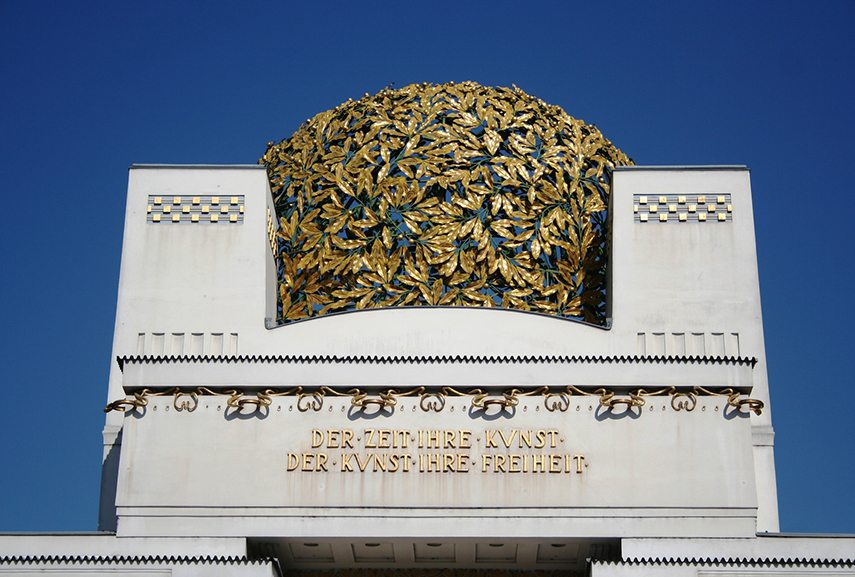
The Dazzler of the Art Nouveau Architecture
Art Nouveau appeared in many different countries at the approximately same fourth dimension, thus you will find its representatives in and exterior of Europe. As this is the instance with architecture likewise, it is quite easy to recognize a edifice influenced by nature, belonging to the eclectic Fine art Nouveau style, anywhere across Western Europe and the United States. Art Nouveau compages was a biggy reproducer of organic forms, simply too a style supportive of scientific advancements. Greatly inspired past curvilinear geometry, its architects were exploring geometry per se, consequently enhancing architecture every bit a discipline. Ane would call it anything but generic, due to the manifold of diverse shapes that one can discover in nature. All the same, all the blinding beauty bated, Art Nouveau was an international manner in essence. What this really means is that even though the body of a building was ornamental, decorated in a manner that could be dubbed every bit "classically" beautiful, the style itself was universal, adopted by a great number of architects from dissimilar parts of the globe, which is exactly what Modernism tried to achieve.
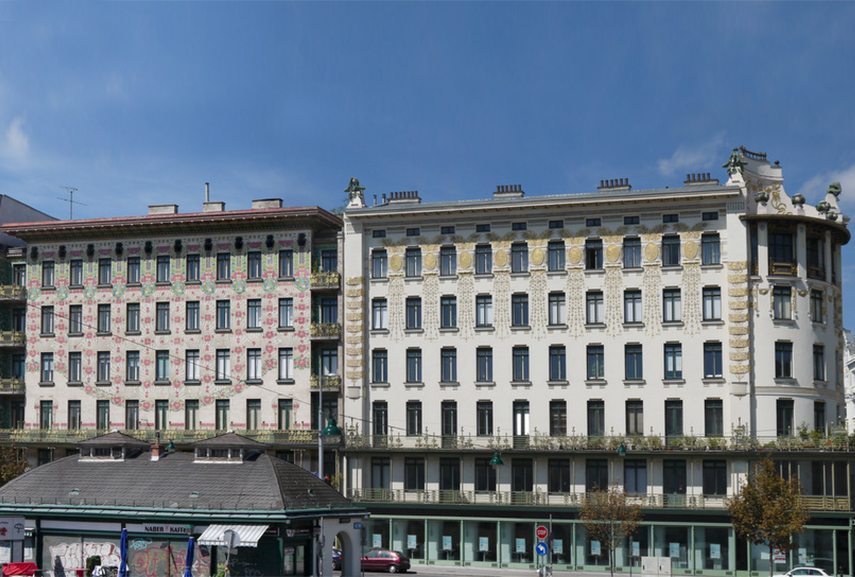
Beautiful Architecture
From a less professional point of view, non everyone would associate Modernist buildings with dazzler. Still, discussing beauty is something that scholars (particularly architects) usually adopt to avoid, since the way nosotros address beauty could be misinterpreted or misunderstood. With Fine art Nouveau on the other paw, in that location is no doubt. Information technology is just one of those types of beauty that goes beyond the eye of the beholder, even beyond the domain of aesthetics (perhaps exactly because it is well rooted in theory, equally well). It's what you would offhandedly call beautiful compages, whether an architect or a complete dilettante - only a sworn Modernist wouldn't acknowledge information technology; simply then again, it is something you lot could analyze, and acknowledge the full potential and the intent backside the project. Nature was not only regarded as an origin of inspiration, it was a dictator of principles, a backdrop which helped create new nature. It appears in most apparent forms, which help u.s. recognize Art Nouveau flowers and leaves on façades, but also in methodology employed past Art Nouveau architects. Nature defined a new architectural language, just like abstruse shapes defined the language of Modernistic architecture.
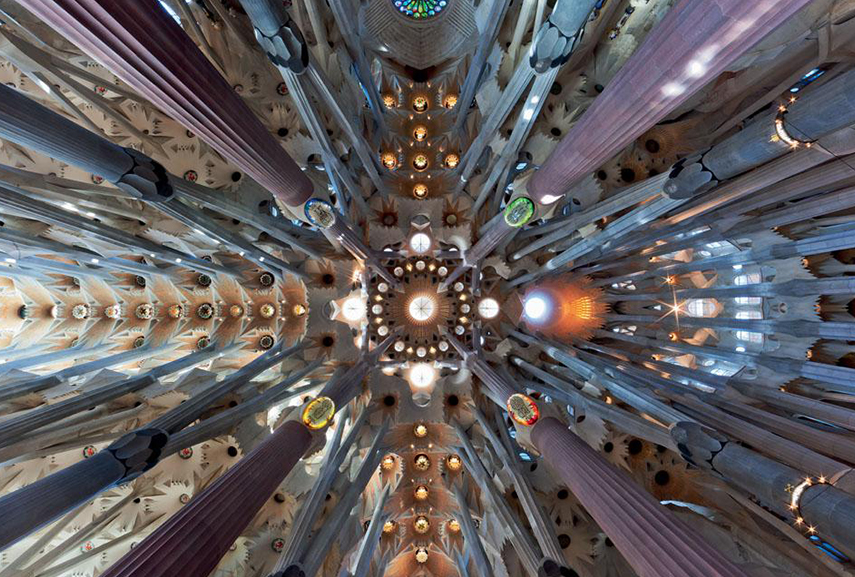
Understanding Art Nouveau Architecture through Gaudi's Work
Ane of the architects commonly related to the motility is Antoni Gaudi, and the link is completely justifiable. Still, the famous Catalan architect was never the type for labels, as he was constantly seeking and producing new things, developing a completely unique vocabulary of his own. He was greatly inspired by the same William Morris, as well every bit some other eminent author William Ruskin. In terms of visual references, Gaudi was interested in oriental arts and the 19th century Gothic Revival, although information technology is a fashion he believed to be "incomplete". The comment on Gothic architecture could be a remarkable reference for Sagrada Familia, Gaudi'southward never-completed masterpiece cathedral in Barcelona, which has an irresistibly gothic-like elegance. However, even though his projects exceed the "universality" of Art Nouveau designs, 1 could accept any of his buildings as a sample on which to observe the principles used by Art Nouveau architects. Nature gave him the clues, and and so he designed his own riddles. Gaudi referenced trees, leaves, and even the human being skeleton through his projects, but this reference was non based merely on plastic imitation; it was, rather, an input for ruled geometrical forms that characterize Gaudi's progressive works. Considering the time in which Gaudi lived, y'all tin can imagine how his projects were practically forcing technology to advance, which is probably one of the most important roles of an builder.
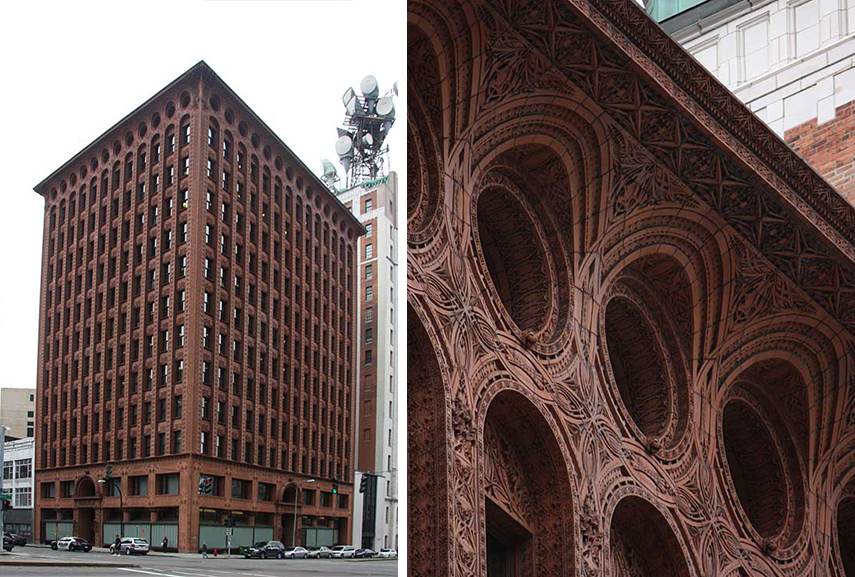
Nearly Representative Fine art Nouveau Architects
One of the almost referenced protagonists of the international "new art" style is Otto Wagner, whose work is associated with the term Secession (due to his Austro-Hungarian origin). Wagner is the writer of the famous Rumbach Street Synagogue in Budapest, the Viennese Church of St. Leopold, and perhaps the most interesting, Majolica Firm, located in Vienna likewise, façade of which was made out of ceramic tiles. Then from another vantage bespeak, you lot should take a look at the works of the American builder Louis Sullivan, who was widely regarded every bit the father of Modernism. This was mostly due to his immense contribution to the design of a modern skyscraper, something that he is well known for today. And you lot may have guessed that well-nigh of his works are skyscrapers, ones that you would have trouble distinguishing from some postmodern skyscrapers across the United States (take the Guaranty edifice in Buffalo, New York every bit an example). Ultimately, ane that was named the fundamental European Art Nouveau architect is the Belgian Victor Horta. His design for Hotel Tassel in Brussels is often mentioned as the commencement edifice to translate Fine art Nouveau from decorative arts to architecture, while his own home stands as a testimony to his time and brilliantly innovative design ideas.
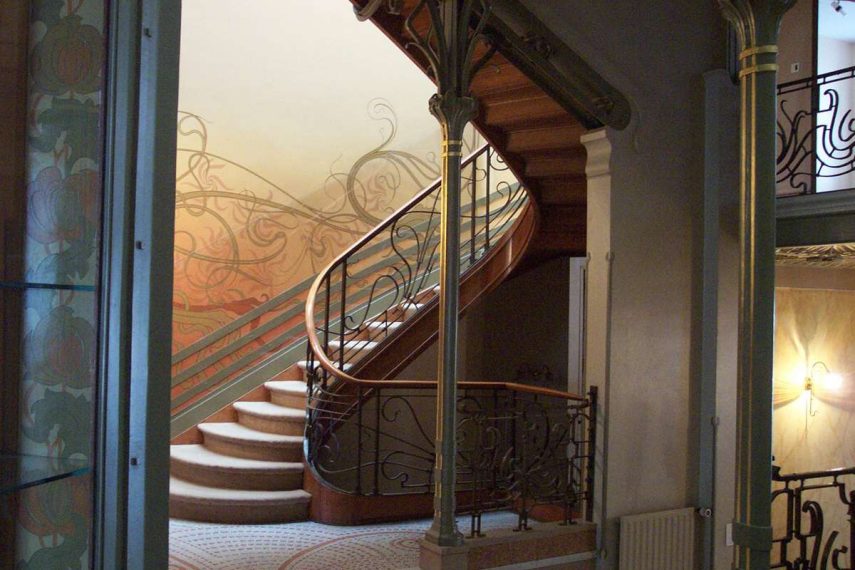
Art Nouveau Painting
Rebellion, transformation and in one case more rebellion, Art Nouveau, the New Art , moved away from the traditional art forms of the 19th-century, and relied on the natural globe, its spirit, which was thought to menstruum intuitively through the soul. The idealized subject field affair of historical and mural paintings, industrialized mass product, and the prevailing art education, were all left behind by art nouveau paintings and the representatives of the new school of art, which chosen for unity of all the arts, arguing against segregation between the fine fine art of painting and sculpture and the so-called bottom art of arts and crafts movement. With this attitude, a synthesis of fine art and arts and crafts was formed, creating a spiritually uplifting Gesamtkunstwerk, assuasive the Fine art Nouveau artists to apply themselves to a broad choice of medium. Where before the artist was thought of as someone painting pictures or making sculpture, now he could blueprint wallpaper, make pottery or illustrate books. As you tin can imagine this opened up an array of unlike disciplines, merely we should keep in listen that during this highly decorative movement the art of painting survived.
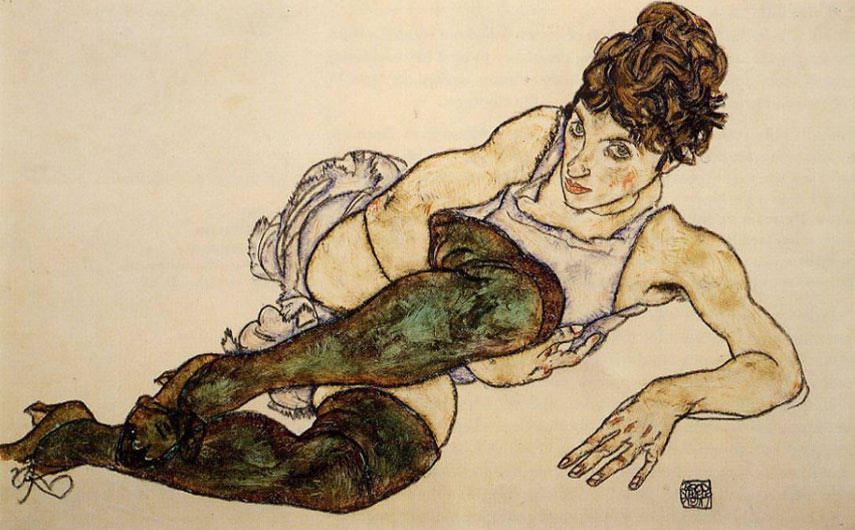
Art Nouveau Painting of Gustav Klimt
The flatness and the decoration, created past the use of lines and ' whiplash ' curves resulting from the botanical studies and illustrations of the abyssal organisms, created the highly ornamental surface of Art Nouveau patterns. This seemed like a stride forward from the Symbolism fine art, whose heritage all the same lingered during the movement. Never a coherent group, artists promoting the new schoolhouse, gathered in different cities and under dissimilar names in various places in Europe. Just, no other group of artists did more to popularize and spread the Art Nouveau style than the Vienna Secessionist, and arguably its virtually productive and influential member was the painter Gustav Klimt. Klimt said:
Whoever wants to know something almost me – as an artist which alone is pregnant – they should look attentively at my pictures and there seek to recognize what I am and what I want.
It is Gustav Klimt who in fact stands every bit a representative of the Art Nouveau painting style. Focusing on the fusion of the symbolism paintings and the to a higher place-mentioned decorative surface, Klimt rejoiced and early on rejected realism. Fusing embellishment and the apartment quality of 2nd, while exploring the ornamental possibilities of painting, with his piece of work Klimt reflected the period'southward love for grandeur and elaboration. His own honey for the royal is seen in his employ of the golden leaf, recalling the Byzantine mosaics for the edifice of his painted surface, which is in the end highly decorative. His love for the ornament and the belief in the equality of fine and decorative art resulted in pieces of work, which can be viewed as a mix betwixt a designed design and realism, which relays on the power of symbolism. This cross between the real and the abstract is an important legacy of Klimt's piece of work and an of import feature of the Art Nouveau Paintings.
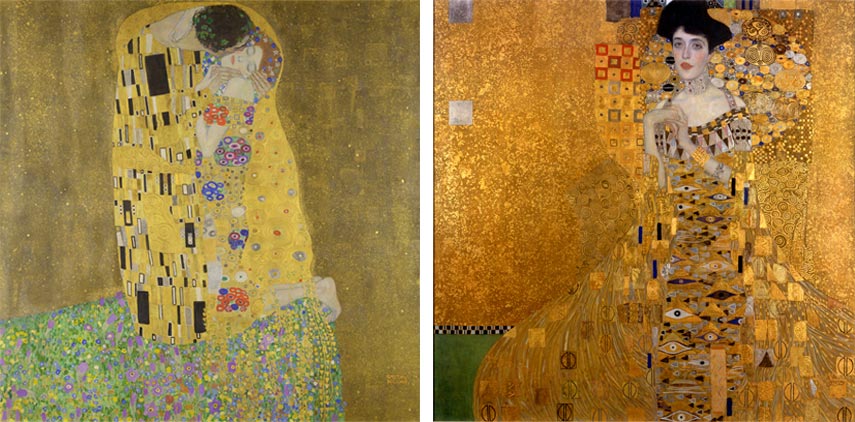
The Variety of The Art Nouveau Painting
The application of the flat quality of Fine art Nouveau way onto an easel painting is, in fact, a difficult job, and we must empathize that, fifty-fifty though the art of painting survived, it took on unlike shapes and possibly a step back to the decorative objects, graphic and impress works, posters and book illustrations. Gustav Klimt, famous for his easel paintings that depicted both allegorical themes and more than traditional form of portraiture fine art, as well produced mural paintings and mosaic art as well. Besides these examples of art nouveau paintings, important for this menstruum are the numerous stained-drinking glass works, produced past yet another influential artist of this time, Louis Comfort Tiffany. The heritage of the most innovative English designers, Pre-Raphaelites, William Morris and Edward Burne –Jones, whose works heralds the movement, were applied with the employ of a new technique that exchanged copper foil method as an alternative to lead, fussing nonetheless again the swirling motifs, the curved line, highly stylized depictions of the human figure this time applied on a different surface, the glass, showcasing the mutual love for patterns, simplicity, and elaborate ornaments every bit a mode of painting of this menses. Unified not only past the legacy of the craft movement, many of the paintings of this menstruation, both on an easel, walls of the buildings, and on glass likewise, showcase the influence of Japanese art, more specifically the woodcut prints.
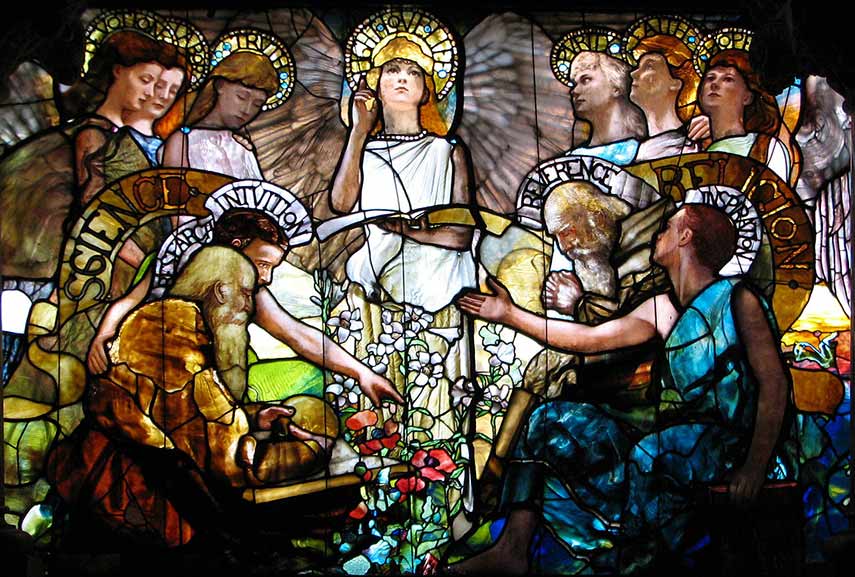
New Adult female of Art Nouveau and the Erotic Fine art
As an important subject matter in the history of fine art, we know that the human class, in particularly, the female body mesmerized artists from the beginning of fourth dimension. During this menstruum, the highly erotized depictions of the cute female form and the erotic nature of many Fine art Nouveau works are ane of the most prevalent features of the painting style. Needing to push boundaries both Gustav Klimt and Egon Schiele produced paintings and drawings, which were highly centered on eroticism. Although Klimt never faced legal problems with his erotic art, his student Schiele had hundreds of his erotic drawings impounded in 1912 on grounds that they were pornographic. The daring new women of art nouveau was sensual, graceful, and delicate, and as well a highly sexual modern adult female of the mean solar day. Used equally an element for advertising past the yet another famous artist of this fourth dimension Alphonse Mucha, the elongated depiction of famous actresses and fantasy women decorated theater posters and diverse illustrations.
The stylized depiction of the human class, decorative and flat surface, along with the play between the real and the abstract are the most of import features, which stay till today as a legacy of this cursory art motility. Fusing the fine art with the art and crafts movement, the art nouveau paintings joined the legacy of symbolism with the new understanding of the painting'southward surface. The world of nature, its flowers, and some of the mysterious creatures helped to shape this era, to whom we owe the time to come evolution of the Fine art Deco period, new and experimental ideas regarding graphic art and poster designs. The Art Nouveau paintings are fifty-fifty today some of the most inspirational images of art history.
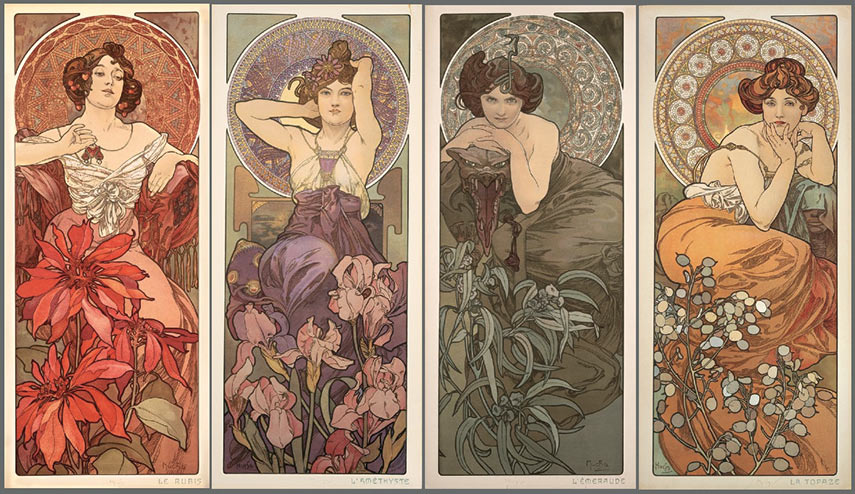
The About Revered Art Nouveau Artists to Remember
For Fine art Nouveau artists, to modernize design at the turn of a new century meant escaping the traditional, eclectic historical styles that have reigned this creative field for far too long. Looking to bring back the good adroitness proposed by the Arts and Crafts movement, while at the same time employing lush ornaments similar to those seen in the Japanese woodblock prints, they drew inspiration from organic and geometric forms everywhere. Practices similar furniture design, glass making, silversmithing, book design and bandage iron work managed to find a place among the already acclaimed creative media such as painting, sculpture and ceramics. Although Art Nouveau had a relatively short lifespan of roughly 15 years, it brought together artists from different countries and backgrounds, thus forming a unique movement based on group achievements rather than highlighting individuals. One hundred years on, their influence and mode are strong and widely appreciated nevertheless.
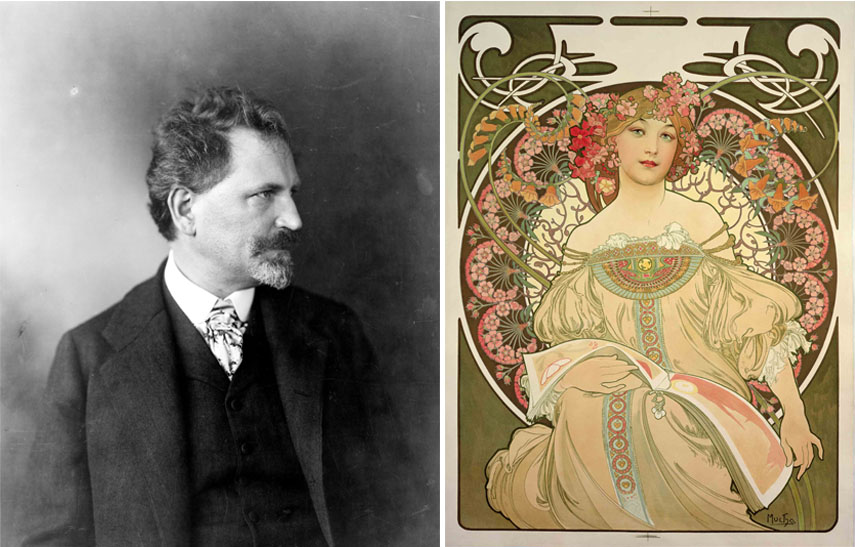
Alphonse Mucha
Alphonse Mucha was a Czech painter and decorative artist whose ordinarily pale pastel creative oeuvre consists of many paintings, illustrations, advertisements, postcards and designs of jewelry, carpets, theater seats and wallpaper. Information technology was a lucky set of coincidences that launched his career in 1894, when he volunteered to create lithographed advertising poster for a play featuring legendary Paris actress Sarah Bernhardt. The collaboration betwixt the ii continues, and Alphonse turned out to be i of the most iconic Art Nouveau artists and a prominent effigy in Czech art history, known for his beautiful, sensuous young women in Neoclassical habiliment, often surrounded by an abundance of flowers and designer patterns. His unique way was given much attention at the seminal Universal Exhibition in Paris in 1900.
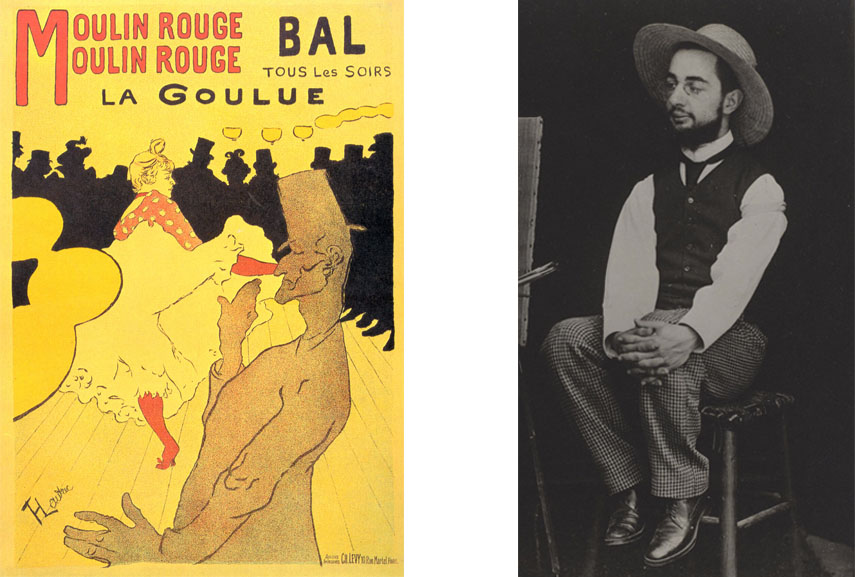
Henri de Toulouse-Lautrec
A keen observer of social culture stripped of glamor, Henri de Toulouse-Lautrec belonged to both Post-Impressionism and Art Nouveau, working as a fine illustrator and lithographer for the latter. His belatedly-19th-century depictions of the maverick lifestyle in Paris are still among the almost remarkable artworks e'er produced, nigh equally famous as his relationship with the Moulin Rouge cabaret, despite his physical disabilities and the fact he was often looked downwardly on him and his work. For Moulin Rouge, Henri de Toulouse-Lautrec produced a series of posters and eventually even showed his artworks on its walls. Amid them, in that location were the portraits of vocaliser Yvette Gilbert and dancers La Goulue and Jane Avril, aslope the scenery from other cabaret clubs and brothels, of which he was a frequent visitor.
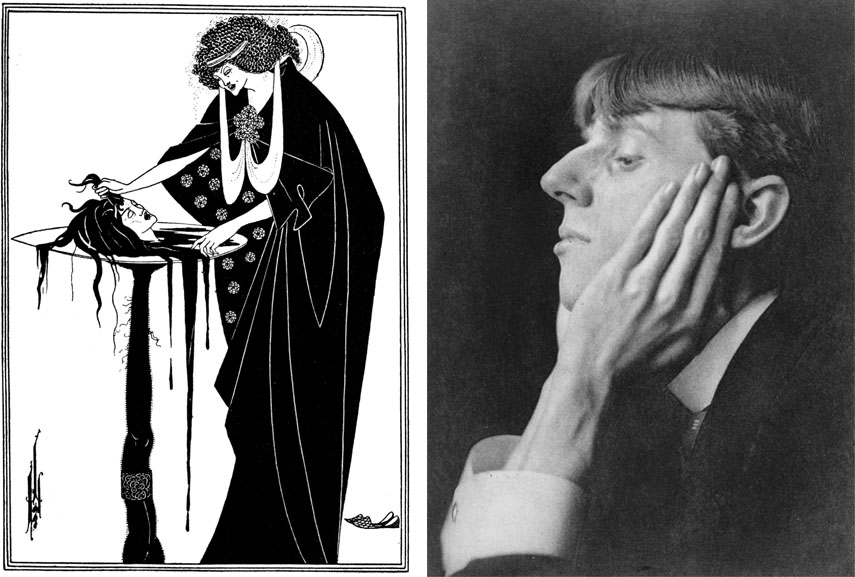
Aubrey Beardsley
His untimely death at the age of just 25 was the one that prevented his talent to grow - and it was a very promising 1. Aubrey Beardsley was an English illustrator and author, best known for his contributions to the Aesthetic motion and of class his illustrations and designs which are considered Art Nouveau. However, his ink drawings weren't at all colorful: using blackness and white but, Aubrey Beardsley created highly contrasted, grotesque, erotic, even corrupt imagery influenced by the works of Henri de Toulouse-Lautrec and, more evidently, the Japanese ukiyo-due east. A caricaturist as well, he oft created political cartoons which mirrored the views of the literary works by fellow artist Oscar Wilde, and was the co-founder of The Xanthous Book magazine, along with American writer Henry Harland, of which he was an editor and produced embrace designs and illustrations.
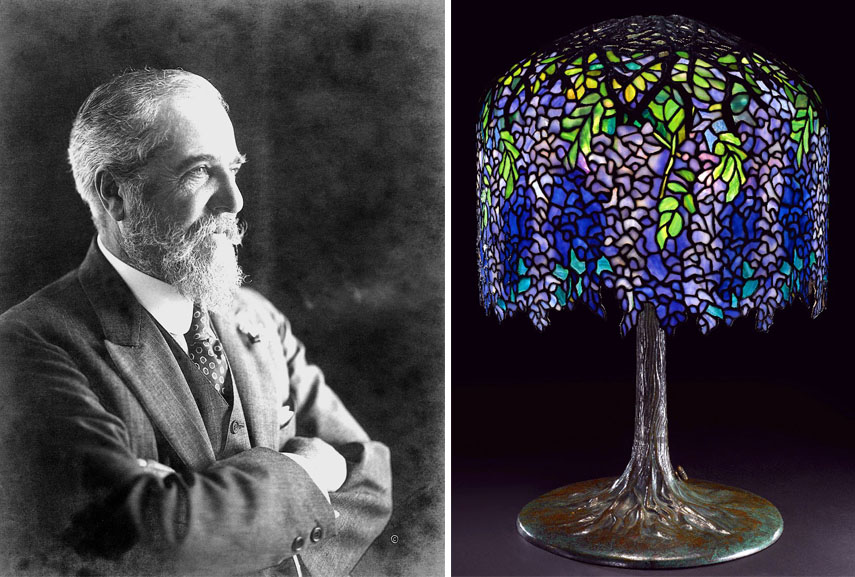
Louis Comfort Tiffany
Louis Comfort Tiffany'due south remarkable artistry which spanned roughly fifty years fitted the aesthetics and the visions of Art Nouveau artists perfectly. But he wasn't a painter, or sculptor, or just one of the designers - he was an iconic decorative arts maker, best known for his piece of work with stained glass. Oftentimes inspired by foreign cultures and natural elements, Louis Comfort Tiffany created a vast variety of objects like pottery, mosaics, metal works, enamels and jewelry, all the while designing windows, interiors, lamps, glasses and much more. His creations can now be establish across the The states and across, such equally the Mark Twain House in Connecticut, many church windows and the White House itself, more specifically its East Room, Blue Room, Red Room, the State Dining Room and the Foyer. His additions were removed in 1902.
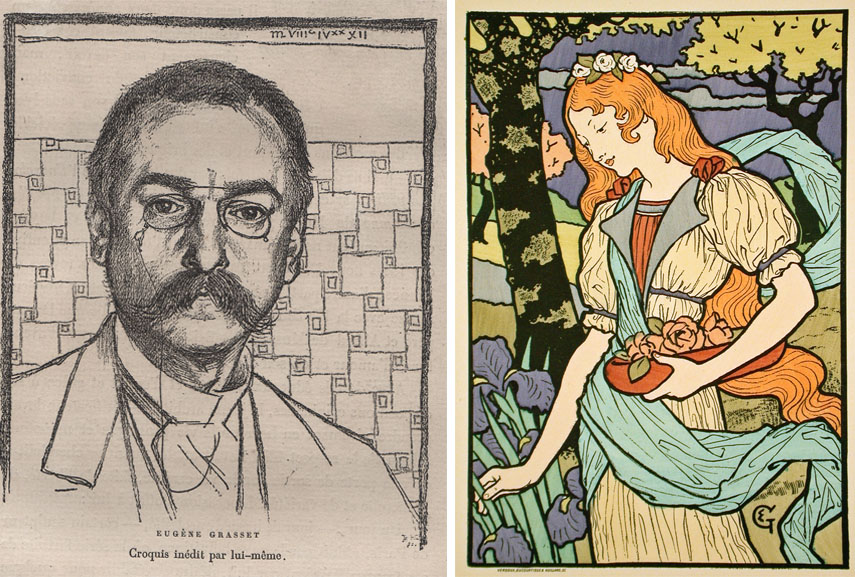
Eugène Grasset
Considered one of the movement'due south pioneers, Eugène Grasset was indeed one of the almost versatile artists. Influenced by his trips to Arab republic of egypt and a detail analogousness towards Japanese aesthetics, his art ranged from painting and sculpture during his days in Lausanne to furniture, fabrics and tapestry design after he moved to Paris in 1871. From at that place, his artistry evolved equally his ornamental pieces were at present made of precious materials such as ivory and gold. Only what Eugène Grasset is maybe most famous for is posters, which likewise brought him fame in the United States; there, he designed covers for magazines like Harper'due south and Century. In France, his lithograph featuring Sarah Bernhardt ended up being a role of Les Maîtres de l'Affiche, an associates of 256 color lithographic plates used to create a publication during the Belle Époque.
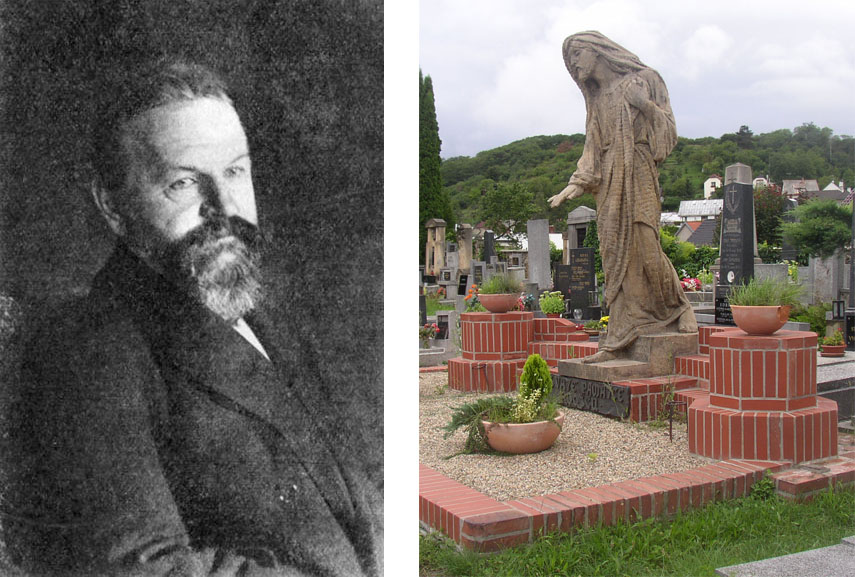
František Bílek
A sculptor and architect, František Bílek was a Czech visionary artist whose creations are often described every bit mystical, religious and mysterious. Partially color-blind, he abandoned his passion for painting and focused on sculpting instead, depicting biblical scenery and stories from the life of Jesus Christ, though surely not following the Neo-Romantic ideals. Working primarily with wood, František Bílek made sculptures from poplar, oak and lime, simply also bronze and ceramics, oft featuring expressive, intriguing, drastic figures. The artist sometimes combined the Oriental with Christianity while tackling the feeling of guilt and promise, emphasized through evocative moving gestures. Many of his works can be found in a villa he built for himself in Hradčany, which is now serving as his museum.
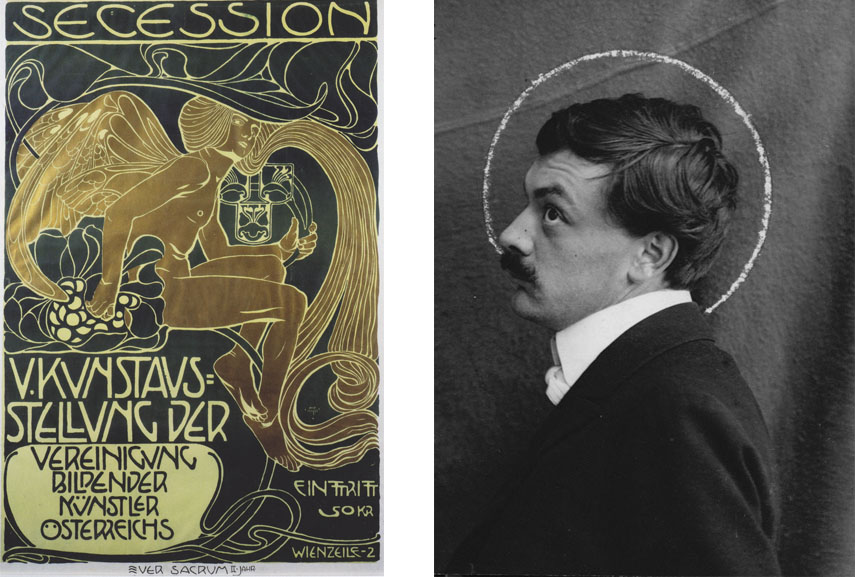
Koloman Moser
Belonging to Vienna Secession, Koloman Moser was also the co-founder of the Wiener Werkstätte, the workshops that brought together artists, architects and designers between 1903 and 1932. He besides is a prominent representative of most all fields and media in Austria during the Art Nouveau period, which of class include architecture, furniture, graphic pattern, tapestry, jewelry, postage stamps, printmaking, ceramics, stained glass windows, even fashion too. Koloman Moser's clean style can be distinguished by precise lines and repetitive motifs of classical Roman and Greek art and architecture, as a response to the Viennese Baroque decadence. Today, his stiff influences can be seen in the works of Shepard Fairey, in particular his extended version of Moser'due south 1901 cover of Ver Sacrum journal.
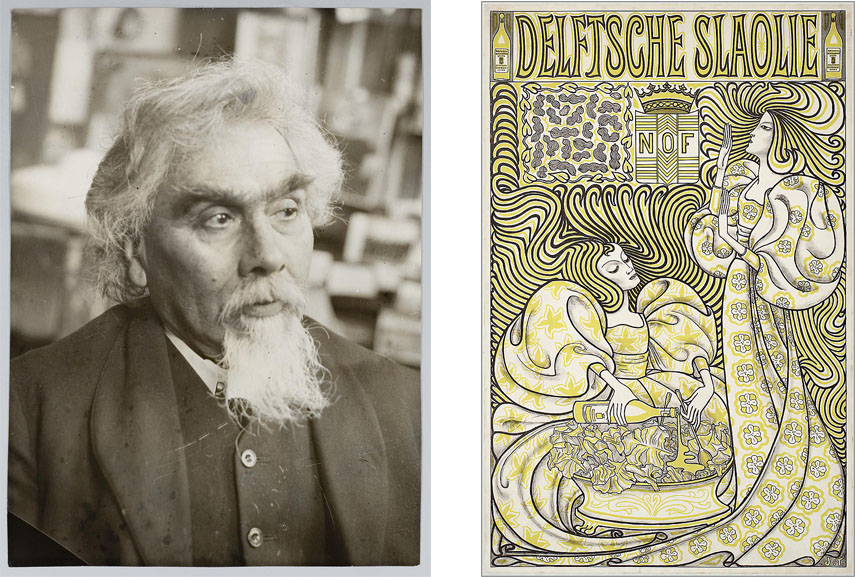
Jan Toorop
A Symbolist, a Pointillist and an Art Nouveau artist, Dutch-Indonesian painter Jan Toorop produced artworks which were to serve decorative purposes, without whatever credible symbolic meaning. Already in his paintings from the Symbolism period, he dedicated himself to the unique Javanese motifs, accompanied by highly stylized willowy figures and curvilinear designs. Aside from portraits, which range from sketches to paintings, Jan Toorop besides created book illustrations, posters and stained glass designs equally function of the Nieuwe Kunst movement. In the Netherlands, he is mostly known for his advertising poster for Delft salad oil, which besides influenced the Dutch Art Nouveau manner to exist chosen "slaoliestijl" - "salad oil way". As such, his ever-evolving style was a major source of inspiration for Gustav Klimt.
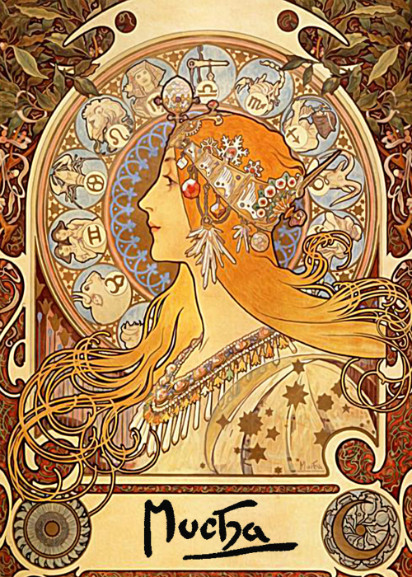
Fine art Nouveau Posters - The History of the Beautiful Commercial
In improver to architecture and fine arts such as painting, any serious discussion of this important stylistic movement must consider Art Nouveau posters and the vast influence they had on the world of graphic design. Making fine art a daily thing for people, the poster was the ways through which Art Nouveau reached a mass audience and widespread popularity. The recent advancement in press technologies such as multiple-color lithography, that allowed more sophisticated range of tones and easier large-scale production, resulted in a then-called poster craze during the belatedly 1880s and 90s. As a dominant form of mass communication, the affiche, or the and then-called 'fine art of the street', was widely used to promote products and amusement and stimulated new heights of artistic expression.
Largely reliant upon form, line and colour, Art Nouveau proved to exist the ideal poster design at the time. It was the showtime major stylistic movement in which mass-produced graphics played a key function in its development. The key influence for popularizing the new artistic style to the citizens of Paris was the affiche created by the Check-born creative person Alphonse Mucha for the Victorien Sardou's play Gismonda in 1894. Epitomizing the Art Nouveau idiom, this poster, that was a purely decorative portrayal of feminine beauty, is considered to exist a masterpiece of Fine art Nouveau. With various influences including the Pre-Raphaelites, the Arts and crafts Movement, and Byzantine art, this extravagant, flowering, ornate style with curved lines has shortly spread to the balance of the Europe and the United States due to the poster boom. Influenced by the French masters such as Mucha, Jules Cheret, Georges de Feure, Eugene Grasset or Albert Guillaume, artists such every bit Henri Privat-Livemont in Kingdom of belgium, Henry van de Velde in The netherlands, Adolfo Hohenstein and Leopoldo Metlicovitz in Italy, or movements such as Viennese Secession started to sally. Fine art Nouveau dominated Parisian poster scene and flourished across Europe upwards until World War I. It began to lose its vitality in France subsequently Mucha and Cherat dedicated themselves to painting, and artists everywhere started to reject Art Nouveau in favor of Art Deco. Today, Fine art Nouveau posters attract many art collectors as an important record of the artistic ideas prior to World War I. So, let's take a look at the most famous Art Nouveau posters!
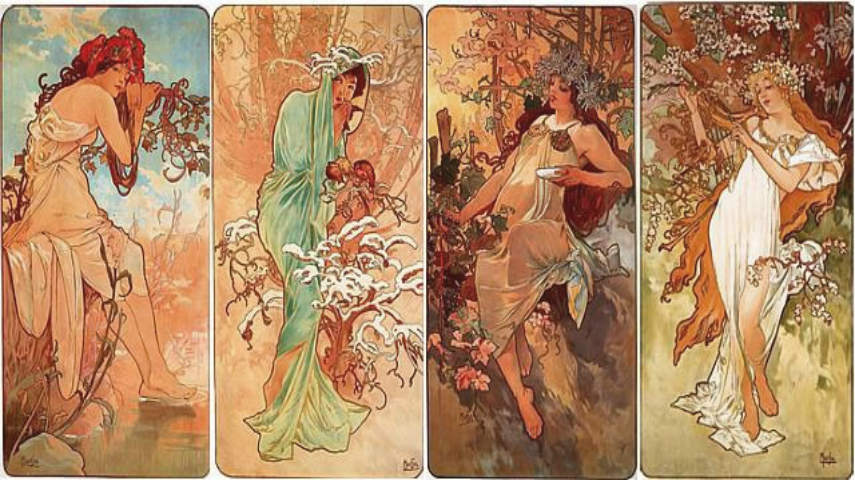
Alphonse Mucha – Gismonda, 1894
Alphonse Mucha, a Cheque-built-in creative person and one of the leading figures of Fine art Nouveau, has completely transformed the art of the poster. The affiche for Victorien Sardou'due south play Gismonda featuring Sarah Bernhardt is ane of his most celebrated pieces that made him famous overnight. Afterward wandering into a Paris impress shop but before the Christmas 1894 and learning that a new play opening in the New Year with Sarah Bernhardt in the lead office needed a new advertising poster, he agreed to create it in merely fourteen days. He portrayed Sarah Bernhardt as an exotic Byzantine noblewoman wearing a excellent costume and an orchid headpiece from the last human action of the play in a rich diversity of colour and decorative detail. Alphonse'southward beautiful and revolutionary design has landed him an sectional half dozen-twelvemonth contract with the famous actress.
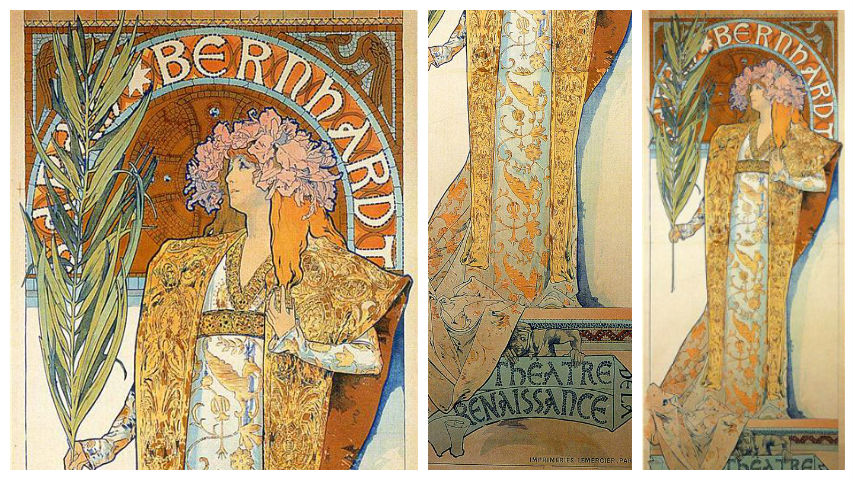
Walter Crane – Champagne Hau & Co. Reims, 1894
An English artist and book illustrator, Walter Crane is considered to be the most influential and i of the nearly prolific children's book creators of his generation. Additionally, Crane designed Art Nouveau textile and wallpapers that became internationally popular and contributed substantially to the poster motion in England as one of its pioneers. With immense versatility in decorative blueprint, Crane's posters were ever marked past fine gustation. Issued in 1894, Crane's colour lithograph affiche was designed to advertise Hau Champagne. The poster shows an allegorical female figure entwined with vines carrying a jug on her shoulder and holding and outstretched chalice.
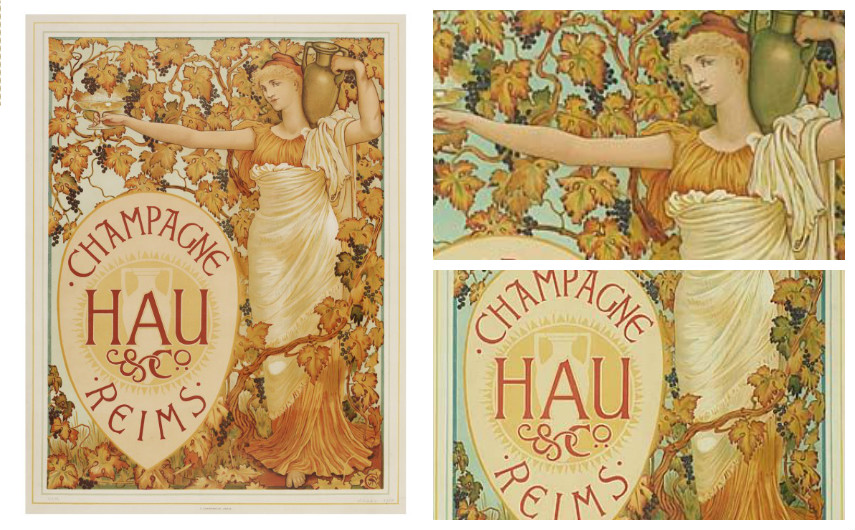
Eugène Grasset – Encre L. Marquet, 1892
The Franco-Swiss decorative artist Eugène Grasset is considered to be a pioneer in Fine art Nouveau style. Initially emerging in the earth of graphic blueprint in 1877 with postcards and postage stamp stamps, Grasset soon started to create commercial artwork in the course of a poster that became his forte. He has fifty-fifty introduced Grasset Italic typeface in 1890 that was subsequently used in the bulk of his posters. His poster for the Encre Fifty. Marquet ink created in 1892 visually translates the inner turmoil of a writer's block. The poster depicts a lady with a peppery pilus and a laurel wreath leaning on a harp - a classical symbol of contemplation – that will soon fill her pages cheers to Fifty. Marquet ink.
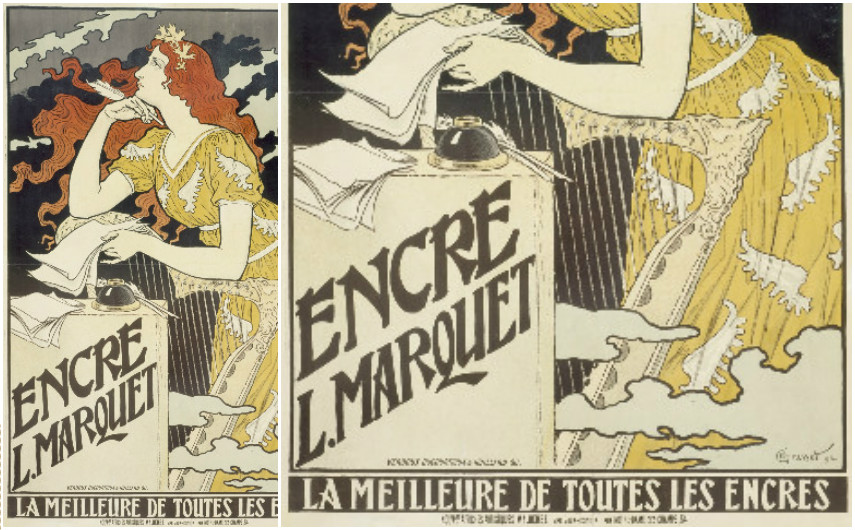
Henri Privat-Livemont - Absinthe Robette, 1896
A Belgian artist Henri Privat-Livemont is ane of the all-time of the postal service-Mucha Art Nouveau masters. Produced in 1896 during the height of popularity of Absinthe, Privat-Livemont'south poster for Absinthe Robette, a trademark of the Distillerie Petitjean & Cie founded in Mons in Belgium, is one of the well-nigh recognizable images associated with this spirit and Art Nouveau in general. Portraying a classically-styled maiden in a sheer gown holding a glass of absinthe as though bestowed from the gods, the groundwork of the poster is dominated by the recognizable green colour of the potable. This timeless masterpiece has since attracted many collectors and inspired a plethora of artists.
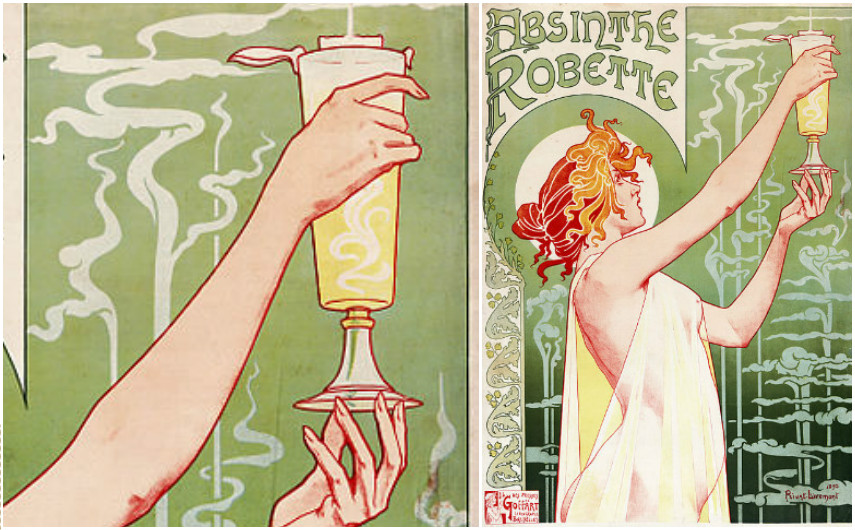
Alphonse Mucha - Chore Cigarette papers, 1898
Another piece by a celebrated artist Alphonse Mucha, the affiche for Job Cigarette papers is arguably one of his best-known advertizement posters. Portraying a prominent female effigy against a background featuring Job monograms, this poster established the iconic image of the 'Mucha woman' with swirls of lavish hair. Showing a woman with a lit cigarette in her hand and a ascension smoke forming an arabesque around her, the brand's name written in mosaic is partially obscured and repeated in the background in a clever logo. Using hair and smoke to unleash radical new decorative forms, this poster is a fine example of the apply of realistic elements every bit decorative crops upward typical of Fine art Nouveau.
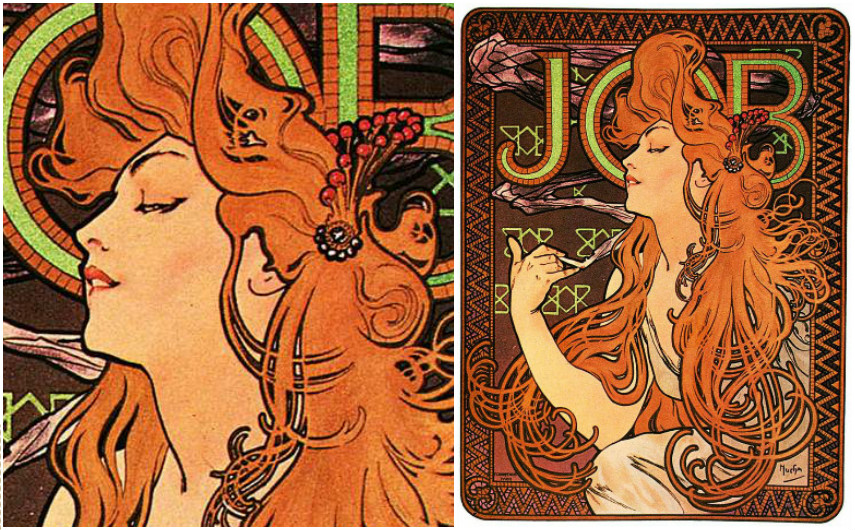
Elisabeth Sonrel – Roger et Gallet
Elisabeth Sonrel was a French painter and illustrator that mainly worked in the Art Nouveau mode. Her oeuvre included allegorical subject, mysticism and symbolism, portraits and landscapes. In her early years, she has also produced many posters, postcards and illustrations that were mainly portraying beautiful women with lavish pilus depicted in the typical Art Nouveau decorative fashion. One of her most famous posters is the one for Roger et Gallet, a firm of French perfumers that specialized in toilet soap and perfumes. The poster portrays a woman surrounded with flowers and belongings a bouquet of violets, referring to the newly synthesized fragrance of violet that the firm has introduced by the end of the 19th century.
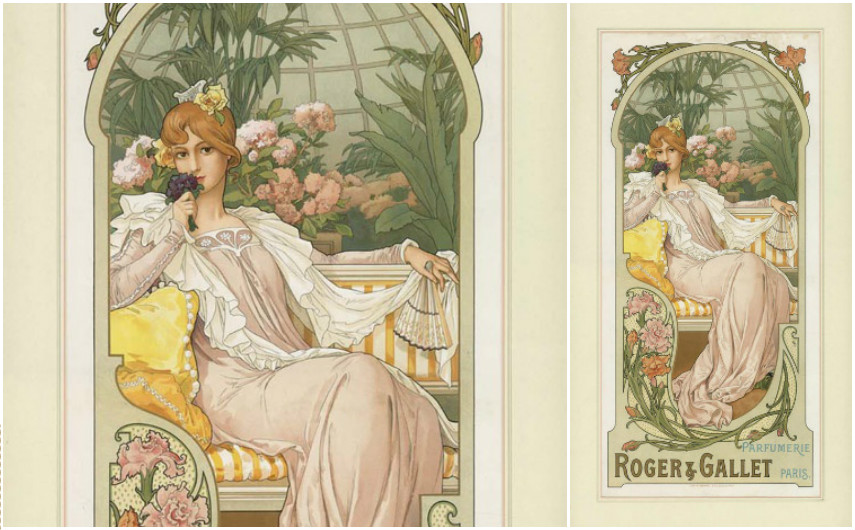
The Legacy of Art Nouveau - Designs, Patterns and Flowers
The Art Nouveau movement is at its purest and is about successful when applied to a purpose other than the easel painting. Every bit understood from the above texts, the movement, and its elegance lend itself very well to graphic reproduction and other forms of art such as decorative stained glass paintings and compages. The affiche designs of the period used the flat areas of color, an essential chemical element of lithographic technique, to produce some of the most elaborate examples of mod pattern, which lingers today in the styles and aesthetic quality of numerous graphic artists and illustrators. But, if I were to ask you, what is the first thing that comes to mind when i thinks about the legacy of Fine art Nouveau I am sure that most of you would think most the lavish organic blueprint design, flowers and diverse household objects decorated with the use of organic shapes and line.
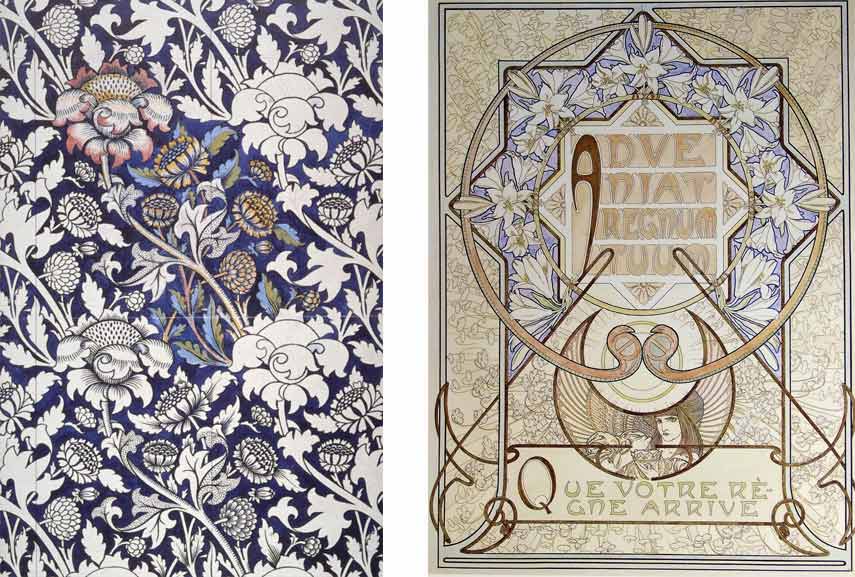
The Art Nouveau Pattern Design
As an important predecessor to the movement, we have mentioned numerous times in this article the Arts and Crafts Movement and we must understand that the pattern design and approach to art we have come up to know equally Art Nouveau is in fact rooted in the understanding of different designers and artists that came earlier. The pattern designs by the famous English designer William Morris and his understanding of the part of an artist profoundly influenced artists and designers of Art Nouveau movement. Concentrating on the revival of practical art, Morris was also influential in the transformation of pattern designs. Before Morris, fabric design used to be three-dimensional and illusionistic in character. Often, large cabbage roses would take been drawn with some perspective and shading, an upshot that tended to exist fussy. What Morris did was to flatten the blueprint, removing whatever attempt to correspond flowers or birds realistically.
The emphasis was switched from the subject matter to color and line of dandy complexity and richness. The flat surface, as we accept understood from the previous chapter on Fine art Nouveau Paintings, was an important chemical element of the move's fashion. The highly abstruse quality of pattern designs in Gustav Klimt'south paintings played with the border of brainchild and realism. Build with the fusion of natural shapes and difficult edges of geometrical shapes, Art Nouveau pattern design is usually created with the stylized images of flowers, curved lines, and spirals and quite muted and somber colors. Mustard, sage green, olive green, chocolate-brown, lilac, violet, purple, and peacock blue are the colors we take come to know as Art Nouveau colors. These patterns were often used for various decorative purposes helping to emphasize the thought that fine art is an integral and important part for the fabrication of quality living.
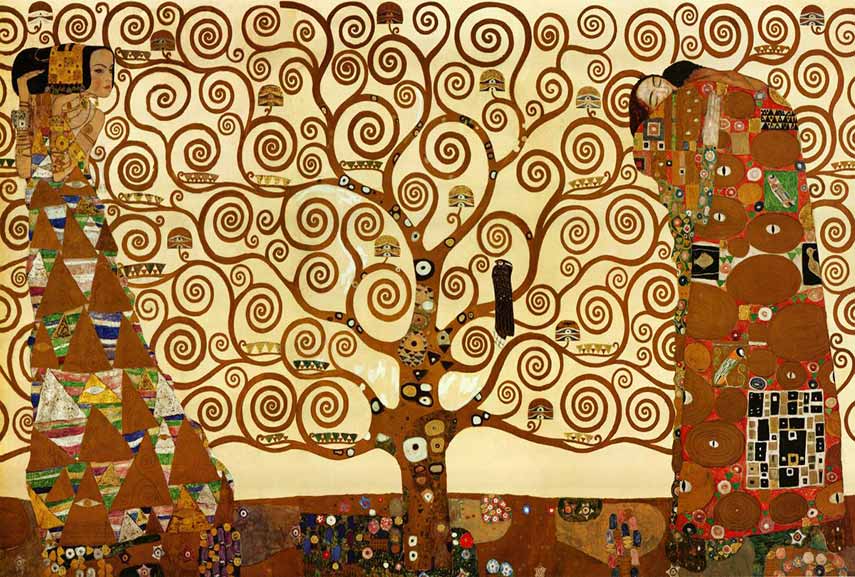
The Flowers of Art Nouveau
The trademark pattern of lines and floral backgrounds institute in the paintings of Vincent Van Gogh and Paul Gauguin, aslope the Japanese woodcut prints were inspirations backside the understanding of the line and color, and likewise for the stylized approach in depiction of natural forms and shapes by the artists and designers of the new art movement. Viewing the ornament as a structural symbol and an important part of the growing force of nature, the artists produced elaborate patterns with the utilize of rhythmic abstraction and stylized images of nature. Flowers, roots, buds, seedpods, and elements including the tulips, sunflowers, combined with lines and simple planes, forth with peacock feathers became the image of art nouveau style. The two-dimensional pieces of art, build with the utilize of the floral motifs and extravagant, flowing and curved lines were painted and printed in popular forms such as advertisements, labels and magazines, and the big number of household items, such as cups, plates and saucers, along with furniture pieces, were busy with ornaments build from the aforementioned elements.
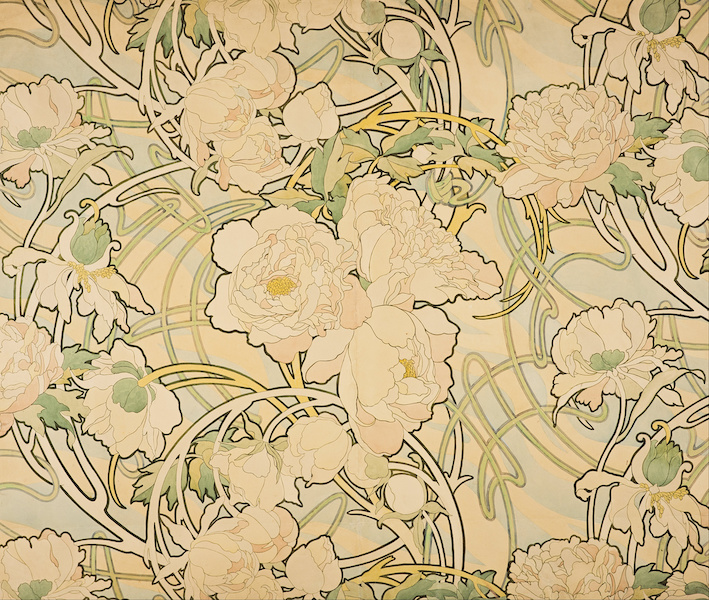
The Art Nouveau Heritage
Although the movement had arapid decline, afterwards 1910 it already vanished, its importance in applied arts, graphic design, and architecture remains overwhelming. It even so has a great influence onillustrators and contemporary artists and nosotros can even say that its stylistic qualities have seen a revival in the rise ofpostmodernism pattern. No other catamenia in the history of art had such an influence on the development of graphic works, and the apply of the repetitive patterns, big blocks of color, and lavish ornamentation is very much live today. Apart from these elements that depict the aesthetic quality of Art Nouveau, peradventure the virtually crucial element is the re-definition of the artist'southward role and the focus on the revival of practical arts. This allowed the creative person to think outside of the box of easel paintings and sculpture and to branch out into dissimilar areas. Much of the jewelry, article of furniture and interior design examples we have today, we owe its artful quality to the experimental artists and designers of the by.
Written byNatalie P,Angie Kordic,Silka P andElena Martinique.
Featured images: Alphonse Mucha - Reverie (particular). All images used for illustrative purposes only.
Source: https://www.widewalls.ch/magazine/art-nouveau-history-and-legacy
0 Response to "How to Paint Ins the Style of Art Nouveau"
Post a Comment